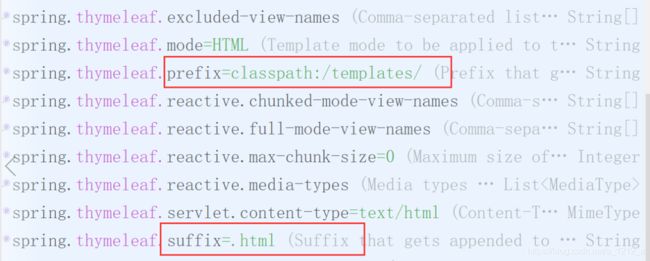前端模板引擎Thymeleaf的简单应用笔记
一. Thymeleaf的介绍.
Thymeleaf 是一个web端的并且独立的Java模板引擎,他能够处理HTML、XML、JavaScript、CSS以及纯文本,Thymeleaf的理念是创建一种优雅和易维护的模板,为了实现这一点,它建立在自然模板之上,将逻辑注入到模板文件中,还不会影响到模板被用作设计原型。Thymeleaf一开始就设计了Web标准,SpringBoot官方推荐使用Thymeleaf 而不是JSP。
JSP:
1.Jsp的本质是Servlet,就是一个.class,如果在jdk1.7以及之前,如果Jsp页面的数量足够多的话,会导致一个问题,项目无法启动.
JVM -> jdk1.6,jdk1.7,jdk1.8方法区的实现都是有所不同的.
2.Jsp页面可以嵌套Java代码的<% %> ,会破坏MVC模式,导致耦合过高.
3.Jsp页面需要引入一个jstl标签库才可以实现一些特有的功能.
4.SpringBoot默认不支持Jsp的.
Thymele:
1.SpringBoot默认支持Thymeleaf,并且主推Thymeleaf.
2.Thymeleaf是以html页面为模板的,只需要添加一个约束即可实现动态效果.
3.Thymeleaf提供了各种各样的表达式,让你可以在页面中疯狂的操作.
4.Thymeleaf可以让前端人员专门使用html做页面开发,并自己添加测试数据,之后交给后台人员,可有在不修改前端页面的前提下,动态填入数据.
直接打开html页面,有测试数据.
通过后台controller路径访问,有真实数据.
二. Thymeleaf的入门
#thymeleaf模板基本配置
spring:
thymeleaf:
mode: HTML5
cache: false
encoding: utf-8
1. 创建SpringBoot项目.
2. 导入依赖.
<dependencies>
<dependency>
<groupId>org.springframework.bootgroupId>
<artifactId>spring-boot-starter-thymeleafartifactId>
dependency>
<dependency>
<groupId>org.springframework.bootgroupId>
<artifactId>spring-boot-starter-webartifactId>
dependency>
3. 查看Thymeleaf的配置信息.
4. 编写Controller.
@Controller
public class IndexController {
@GetMapping("/index")
public String index(Model model){
model.addAttribute("info","SpringBoot Thymeleaf!!!");
return "index";
}
}
5. 尝试获取域中的数据.
三. Thymeleaf的$表达式
1. $ 表达式中可以添加的内容. (变量表达式)
Ps: 使用表达式时,一定要在 th:属性名=“表达式”
${}:
1. 可以直接填写域中数据的key,从而获取value.
2. 直接编写文本内容.
字符串,数值,布尔,null
3.在${}中使用四则运算和取余操作也可以.
+ - & / %
4.关系运算符.
> >= < <= == !=
gt ge lt le eq ne
5.逻辑运算符
and or not !
6.三元运算符.
(条件表达式) ? 值1 : 值2
5.Thymeleaf提供了大量的内置对象,可以直接使用.
${#具体的对象}
Servlet中的对象: request,session,response.
工具类: strings,lists,maps,dates....
2. Thymeleaf可以编写的属性.
标签自带的属性,Thymeleaf基本全部都支持.
直接书写style,不需要通过controller转发,即可正常看到样式.
书写 th:style ,需要通过controller转发到thymeleaf页面,style才会被页面正常的解析.
如果通过controller转发到页面,th:的属性会覆盖正常编写的属性.
Thymeleaf!!
1.text与utext
String text = "点我有惊喜";
String utext = "点我有惊喜";
model.addAttribute("text",text);
model.addAttribute("utext",utext);
Hello Thymeleaf!!
-> 不会解析内容,将其当做纯文本
Hello Thymeleaf!!
-> 会解析内容中标签.
2.从域中取出一个对象时,如果将对象中的属性展示到页面.
public class User {
private String name;
private Integer age;
private Date birthday;
private String hobby;
}
更优雅的方式:
方式2:
3.遍历一个集合并获取其中的全部对象并展示.
list
map
4.数据回显.
1. 文本内容回显.
2.时间类型回显. 无法使用field
3.下拉列表回显.
5.逻辑判断.
th:if=“boolean” th:if的表达式需为boolean值。如果为true,则标签显示,如果为false,则标签不显示。
th:unless=“boolean” th:unless和th:if相反,表达式也需为boolean值。如果为true,则标签不显示,如果为false,则标签显示
<h1 th:if="${user.age ge 18}">已满18岁,可以进入,网吧h1>
<h1 th:unless="${user.age ge 18}">返回false展示当前标签内容h1>
<div th:switch="${user.age}">
<h1 th:case="88">刚好88岁h1>
<h1 th:case="28">刚好28岁h1>
<h1 th:case="*">不是18岁,也不是28岁.h1>
div>
6.绑定事件传参.
如果需要在绑定事件时,传递参数到函数中,需要使用到thymeleaf另一个语法来书写.
到了js中,也需要去域中获取值,在js中编写时,就需要先**[[ 内部写表达式 ]]**
四. Thymeleaf的路径处理,@ 表达式
书写请求路径:@{} -> 链接|路径表达式.
访问controller方法
访问静态页面
使用@{}帮助我们在js代码中获取项目路径
th:inline="javascript" 解析js代码中的thymeleaf关键字.[[]]
th:inline="none" 不去解析js代码中的thymeleaf关键字.[[]]
静态资源,统统放到resources下的static目录中,这个目录和传统的web项目的webapps目录一致
模板引擎,统统放到templates下,这个目录和传统的web项目的WEB-INF一样.
ps:如果在代码出错时,templates下有一error.html页面时,会自动跳转到这个页面中.
五. Thymeleaf的页面引入
创建footer.html文件用下面的内容替换
<meta http-equiv="Content-Type" content="text/html;charset=UTF-8"/>
<footer th:fragment="companyInfo">
<p>设为首页 SpringBoot 使用<span th:text="${projectName}"/>前必读 p>
footer>
可以看到页面当中还存在一个变量projectName,这个变量的值可以在引入页面中通过 th:with=“projectName=百度” 进行传值引入页面中只需要添加如下代码即可
– 替换内容
– 替换全部
~片段表达式.
Thymeleaf的片段表达式 ~{}
1. 声明片段.
单独创建一个thymeleaf页面.
声明具体的标签内容之后添加一个属性th:fragment=“片段名”
2.引用片段.
th:insert="~{页面名 :: 片段名}" 将整个片段插入到th:insert所在的标签体内.
th:replace="~{页面名 :: 片段名}" 将整个片段替换掉th:replace所在的标签.
th:include="~{页面名 :: 片段名}" 将片段中位于fragment属性标签体内的内容,插入到th:include所在的标签体内.
六.Thymeleaf中的#{}
#{}在html页面中引用外部文件中的内容. 一般使用#{}做国际化i18n.
1.在配置文件中配置
spring:
messages:
basename: messages
准备不同语言的文件.书写一下内容,文件默认命名要求为messages,先创建messges.properties并且放在resources目录下.
messages_zh.properties
language.ch=中文
language.en=英文
username=用户名
password=密码
login=登录
messages_en.properties
language.ch=Chinese
language.en=English
username=username
password=password
login=login
将idea中所有的编码格式设置为UTF-8
settings -> file encoding -> UTF-8
2 创建login.html,并编写内容.
使用#{}引入上述.properties文件中的内容
th:text="#{username}
3 转发到这个页面.
先编写一个配置文件,将需要使用到的SessionLocaleResolver对象注入到IOC容器中.
@Configuration
public class I18nConfig {
@Bean
public LocaleResolver localeResolver(){
return new SessionLocaleResolver();
}
}
在页面的切换中英文的超链接位置添加href属性,并传递参数,指定中英文切换的信息.
在转发到login页面前,通过SessionLocaleResolver对象.setLocale指定具体的语种.
@Controller
public class LoginController {
@Autowired
private LocaleResolver localeResolver;
@GetMapping("/login-ui")
public String loginUI(@RequestParam(defaultValue = "0") Integer i, HttpServletRequest request, HttpServletResponse response){
if(i == 0){
// 要求中文
localeResolver.setLocale(request,response, Locale.CHINESE);
}else{
// 要求英文
localeResolver.setLocale(request,response, Locale.ENGLISH);
}
return "login";
}
}
自动去找messages_??.properties文件中的内容.
注意
1、凡是涉及到thymeleaf模板语法的标签都必须加上thymeleaf模板特有的标志th:
2、SpringBoot在使用thymeleaf模板时,要注意标签闭合
3、在进行SpringBoot整合dubbo时,会出现在模板中使用JavaScript,带有;标识符的语法不能运行报错的问题(比如在thymeleaf模板的JavaScript标签中使用for(;;)循环语句),这时候可以使用外部导入js
文件的方式解决
4、尽量使用HTML5模板(配置文件需要配置),防止出现莫名其妙报错的问题


